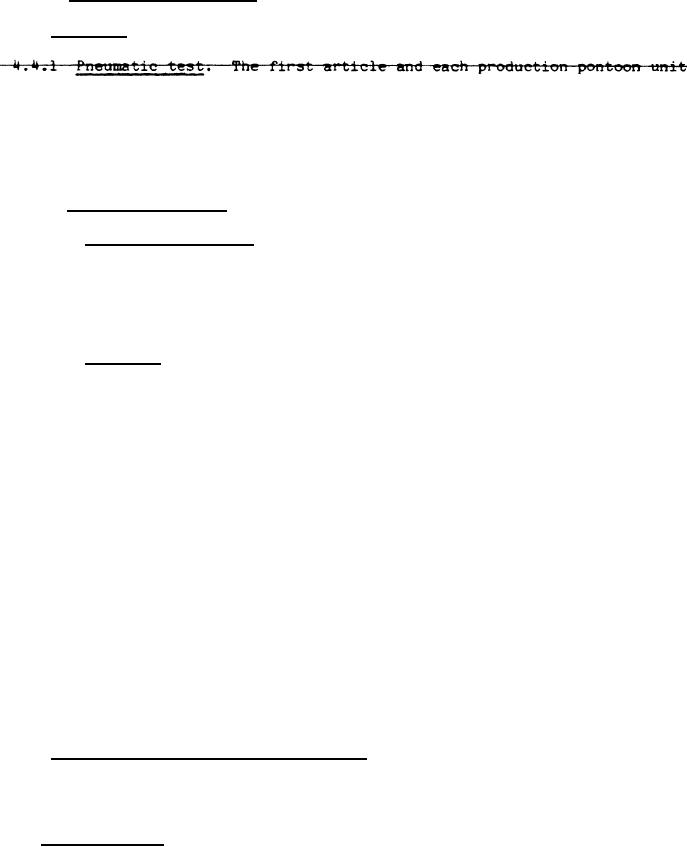 |
|||
|
Page Title:
Preservation, packing, and marking |
|
||
| ||||||||||
|
|  MIL-P-19380/1
4.3.1 Welding examination.
(See 4.5.1 of MIL-P-19380J.)
4.4 Testing.
shall be subjected to pneumatic testing. The assembled pontoon unit shall be
tested for tightness of joints by the application of air pressure of not less
than 5 psi. While the pontoon is under pressure, a soap solution shall be
applied externally to reveal any leaks, or as an option, the pressurized
pontoon shall be given full immersion to detect any leaks. The Government
inspector shall observe the pneumatic test.
4.4.2 Hydrostatic test.
4.4.2.1 Sampling for test. One week's production or 50 consecutively
produced pontoons, whichever is smaller, shall be considered a lot for the
purpose of hydrostatic testing. For lots of five or less, 100 percent of the
pontoons shall be tested. Sample size for lots of 5 to 50 pontoons shall be
five. No rejects will be accepted under the contract until the defect has
been corrected.
4.4.2.2 Testing. The first article and each production unit sampled as
specified in (see 4.4.2.1) shall be subjected to hydrostatic testing. A
hydrostatic test pressure of 20 psi shall be maintained for not less than
15 minutes. Permanent deformation or bulging of plating shall not exceed
1/2-inch between the stiffeners and 1/8-inch at the stiffeners. Measurement
of permanent deformation or bulging of plating between stiffeners shall be
from a straight edge placed at right angles to the stiffeners and over the
point of greatest deformation. Measurement of deformation of stiffeners shall
be from a straight edge placed directly over, in line with, and for the full
length of the stiffener. The water solution used for hydrostatic testing
shall be rust inhibiting by addition of 1/2 of 1 percent by weight of sodium
bichromate chemical. After completion of the test, each pontoon shall be
thoroughly drained by suitable means such as siphoning the test fluid from the
lowest corner inside the pontoon. The pontoon shall be measured and gaged
before and after each hydrostatic test to determine the extent of the
deformation or distortion. The Government inspector shall observe the
hydrostatic test. Any permanent deformation in excess of that specified
herein or any joint failure or leaks shall be cause for rejection.
4.5
Packaging inspection. (See 4.6 of MIL-P-19380J.)
PACKAGING
5.
5.1 Preservation, packing, and marking. Preservation, packing, and identi-
fication marking shall be in accordance with Section 5 of MIL-P-19380J.
6.
NOTES
6.1 Intended use. The Navy P-series pontoons are intended to be coupled
and joined by fittings to form floating and nonfloating platforms and
structures. Various combinations forming pontoon barges, tugs, floating
drydocks, floating cranes and derricks, bridge units and wharves are
delineated in the Navy `Pontoon Gear Handbook" (NAVFAC P401). Pontoons of
different types are listed below.
4
|
|
Privacy Statement - Press Release - Copyright Information. - Contact Us |